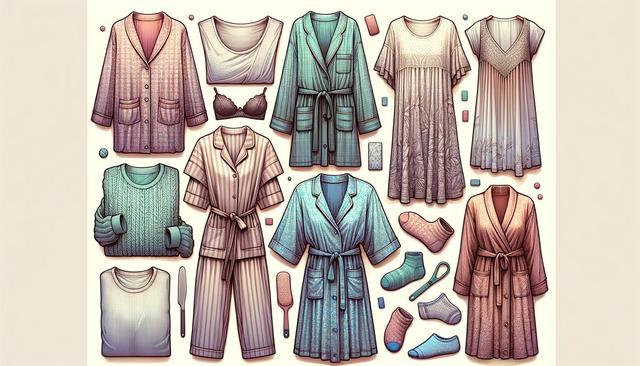Understanding the Role of Sleep Wear in Your Nightly Routine
Sleep wear plays a more important role in our overall sleep quality than many realize. The clothes we wear to bed affect how comfortable and relaxed we feel, which directly impacts how easily we fall asleep and stay asleep. Materials, fit, and even design can influence body temperature regulation, skin comfort, and mental relaxation. Whether it’s a lightweight cotton set or a cozy flannel pajama, the right sleep wear can help signal to your body that it’s time to wind down.
Incorporating a consistent bedtime routine that includes changing into comfortable sleep wear can also contribute to better sleep hygiene. This small action creates a mental shift from daytime activities to rest mode. For those who struggle with winding down at night, this simple habit can support a smoother transition into restful sleep. Over time, your body begins to associate your sleep wear with relaxation, reinforcing positive sleep patterns.
Choosing the Right Fabric for Your Sleep Needs
The material of your sleep wear is one of the most important factors to consider. Different fabrics offer varying levels of breathability, insulation, and skin feel. For individuals who tend to sleep hot, lightweight and breathable materials like cotton, bamboo, or modal are ideal. These fabrics allow air to circulate and help wick away moisture, keeping the body cool and dry throughout the night.
On the other hand, colder climates or winter months may call for warmer options. Flannel, fleece, or thermal blends provide extra insulation without compromising comfort. Here are a few commonly used sleep wear fabrics and their benefits:
- Cotton – soft, breathable, and suitable for most seasons
- Bamboo – naturally moisture-wicking and eco-friendly
- Silk – smooth, luxurious feel and temperature regulating
- Flannel – perfect for colder nights due to its warmth
- Modal – stretchy and breathable with a soft texture
Choosing the right fabric goes beyond personal preference—it’s about aligning your sleep wear with your specific comfort and temperature needs.
Fit and Functionality: More Than Just Style
While the appearance of sleep wear is often a personal choice, the fit and functionality should take priority. Ill-fitting sleep wear can cause discomfort, restrict movement during sleep, or even disrupt rest. Loose-fitting garments are typically preferred as they allow for free movement and better airflow. However, the fit should still be secure enough to avoid bunching or slipping during the night.
Features to consider for optimal functionality include:
- Elastic or adjustable waistbands for flexibility
- Tagless designs to reduce irritation
- Flat seams to prevent chafing
- Button-down tops for easy layering or changing
Sleep wear should support your bedtime habits—whether that’s lounging in the evening with a book or getting up during the night. Functional details can make a significant difference in your nighttime experience.
Seasonal Adjustments and Layering Options
Just as we adjust our daytime clothing with the seasons, our sleep wear should also change throughout the year. Layering is a practical way to maintain comfort across different temperatures without needing an entirely new sleep wardrobe. For example, in transitional seasons like spring and fall, pairing lightweight pajama sets with a soft robe or sleep hoodie can provide flexibility as temperatures fluctuate overnight.
During the warmer months, opt for minimal layers, such as a breathable tank top and shorts. In winter, consider:
- Long-sleeved tops and full-length bottoms
- Soft socks for cold feet
- Layered sleep sets for adjustable warmth
- Warm accessories like sleep masks or light beanies if needed
Seasonal sleep wear ensures that your body stays at a comfortable temperature, reducing disruptions caused by overheating or chills.
Personal Preference and Lifestyle Considerations
Ultimately, the ideal sleep wear varies from person to person, depending on lifestyle, skin sensitivity, and personal comfort. Some may prefer minimalist sleep wear or even sleeping without clothing, while others value the structure and coziness of a full pajama set. Lifestyle choices, such as needing to step outside briefly or co-sleeping with children, may also influence the type of sleep wear that works best.
When selecting sleep wear, also consider:
- Ease of maintenance – machine washable and durable materials
- Allergy considerations – hypoallergenic fabrics for sensitive skin
- Activity before bed – lounging, exercising, or bathing routines
- Personal style – patterns and colors that promote relaxation
By aligning your sleep wear choices with these personal factors, you can build a nighttime wardrobe that supports restful sleep and fits seamlessly into your daily routine.
Conclusion: Sleep Wear as a Key to Better Sleep
While often overlooked, sleep wear is a crucial aspect of sleep hygiene and nighttime comfort. From fabric choices and fit to seasonal adaptability and personal preferences, the right sleep wear can greatly influence how well you sleep. By understanding your needs and making thoughtful choices, you can create an environment that encourages deeper rest and more restorative nights. Investing in comfortable, functional, and seasonally appropriate sleep wear is a simple yet effective way to enhance your overall sleep experience.












